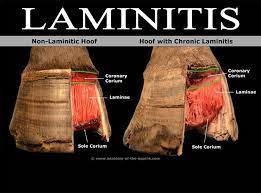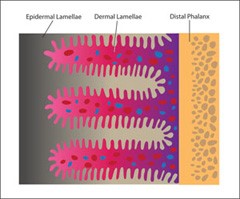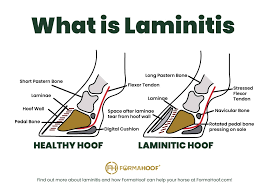Laminitis in Equine
Dr. Somi Ali
College of Veterinary Science & A.H., Mhow
Laminitis is an inflammation of the laminae of the foot. It is a crippling disease in which there is a failure of attachment of the epidermal laminae connected to the hoof wall from the dermal laminae attached to the distal phalanx. It is a peripheral vascular disease manifested by decreased capillary perfusion within foot, arterio-venous shunting, ischemic necrosis of the laminae.
The simplest definition of laminitis is the failure of the attachment between the distal phalanx and the inner hoof wall. A horse has laminitis when the lamellar architecture of the inner hoof wall, which normally suspends the distal phalanx from the inner surface of the hoof capsule, fails. Without the distal phalanx properly attached to the inside of the hoof, the weight of the horse and the forces of locomotion drive the bone down into the hoof capsule, shearing and damaging arteries and veins, crushing the corium of the sole and coronet, causing unrelenting pain and a characteristic lameness.

The hoof wall-coffin bone bond is the only thing that prevents the horse’s body weight from forcing the coffin bone through the bottom of the sole of the hoof. This bond must be strong enough to withstand the forces sustained by the hoof at a gallop, yet dynamic enough to allow the hoof wall to grow. In order to maximize the strength of the hoof wall-coffin bone bond, this interface is connected by several folds known as lamellae and the surface of each lamella is itself folded into many minutes secondary lamellae, because of this the surface area increases many times and thus the strength of the hoof wall-coffin bone bond. Because lamellae are formed by living cells with an extensive blood and nerve supply, the hoof wall-coffin bone bond is susceptible to a wide variety of systemic diseases that can contribute to the development of laminitis.

Etiology:-
- Grain founder- grain founder is caused by ingestion of greater quantities of grain than can be tolerated by the horse.this type of founder associated with gastroenteritis and the grains that most commonly involved are wheat and barley. The toxin histidine known to be formed in grain during digestion is decarboxylated to histamine, which is thought to cause laminitis
- Water founder– Ingestion of large amount of cold water by an overheated horse is considered to be a cause of laminitis.
- Road founder – It is result of concussion to feet from hard work or fast work on a hard surface.
- Post parturient laminitis– This type of laminitis occur after foaling as a result of which portion of fetal membrane retention or a uterine infection without retention of fetal membranes.
- Grass founder– occur because of over grazing on grass pastures. Pastures containing clover and alfalfa apparently more apt to cause the condition of laminitis.
- Severe intestinal disease: Surgical colic or diarrhea
- Sepsis (circulating bacteria in the blood stream) due to, but not limited to:
- Pleuropneumonia
- Uterine infection due to retained placenta in post foaling mares
- Septic peritonitis (infection of the abdominal cavity).
- Exposure to black walnut shavings used for bedding
- Overweight bearing
Contributing Factors
- Various metabolic disorders, generally associated with obesity
- Ingestion of certain ergot alkaloids, which is found in endophyte-infested fescue grass.
- Inactivity (often coupled with obesity)
- Sudden exposure to strenuous exercise
- Stress: high-stress occupation or environment, long-distance transporting, hospitalization
- Poor hoof conformation or improper trimming or shoeing.
Clinical signs:-
Acute laminitis –
1) Lameness
2) Increase in the temperature
3) Increased digital pulses
4) Elicitation of a painful withdrawal response to hoof testers
5) The forelimbs are most commonly affected (most likely due to more weight being borne by the forelimbs); the hindlimbs may also be involved
6) The characteristic gait of a laminitic horse is stiff limb movement while maintaining the same laminitic posture of both fore‐ and hindlimbs being placed anteriorly. Horses in which all 4 feet are affected may have a more normal stance or may appear “camped out” with forelimbs placed more anterior than normal and hindlimbs placed more posterior than normal
7) Heat is present all over the sole,the wall and the coronary band
8) Anxiety
9) Trembling of the musculature from severe pain
10) Increased respiration
- Rotation of the third phalanx
- Separation of sensitive laminae
- The pull of deep flexor tendon at its attachment on the semilunar crest of the third phalanx
- Tendency to land on the heel in an exaggerated motion
- The sole is dropped and flat
- Hoof wall grows more rapidly
- Feet may develop a long toe that urls up at the end
- Heavy ring formation on the wall
- Seedy toe
- Enough separation of white line may occur to to allow infection to penetrate the sensitive laminae
- Bleeding of sole due to more vascularity
Prevention
- Ensure your horse or pony is fed a balanced ration appropriate for their type, age and activity level.
- Restrict access to lush pasture particularly during the wet spring months
- Seek veterinary attention immediately if you suspect your mare has retained placenta (12 hours later can be too late) or if your horse is otherwise unwell
- Ensure your horse receives regular hoof care from a reputable farrier.


